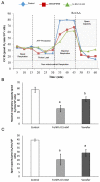Ultra-Small Iron Nanoparticles Target Mitochondria Inducing Autophagy, Acting on Mitochondrial DNA and Reducing Respiration
- PMID: 33445442
- PMCID: PMC7827814
- DOI: 10.3390/pharmaceutics13010090
Ultra-Small Iron Nanoparticles Target Mitochondria Inducing Autophagy, Acting on Mitochondrial DNA and Reducing Respiration
Abstract
The application of metallic nanoparticles (materials with size at least in one dimension ranging from 1 to 100 nm) as a new therapeutic tool will improve the diagnosis and treatment of diseases. The mitochondria could be a therapeutic target to treat pathologies whose origin lies in mitochondrial dysfunctions or whose progression is dependent on mitochondrial function. We aimed to study the subcellular distribution of 2-4 nm iron nanoparticles and its effect on mitochondrial DNA (mtDNA), mitochondrial function, and autophagy in colorectal cell lines (HT-29). Results showed that when cells were exposed to ultra-small iron nanoparticles, their subcellular fate was mainly mitochondria, affecting its respiratory and glycolytic parameters, inducing the migration of the cellular state towards quiescence, and promoting and triggering the autophagic process. These effects support the potential use of nanoparticles as therapeutic agents using mitochondria as a target for cancer and other treatments for mitochondria-dependent pathologies.
Keywords: copy number; metals; mitochondria; mtDNA deletions; nanotechnology; respiration.
Conflict of interest statement
The authors declare no conflict of interest.
Figures











References
-
- Amendoeira A., Rivas García L., Fernandes A.R., Baptista P.V. Light Irradiation of Gold Nanoparticles Toward Advanced Cancer Therapeutics. Adv. Ther. 2020;3:1900153. doi: 10.1002/adtp.201900153. - DOI
Grants and funding
LinkOut - more resources
Full Text Sources
Other Literature Sources

